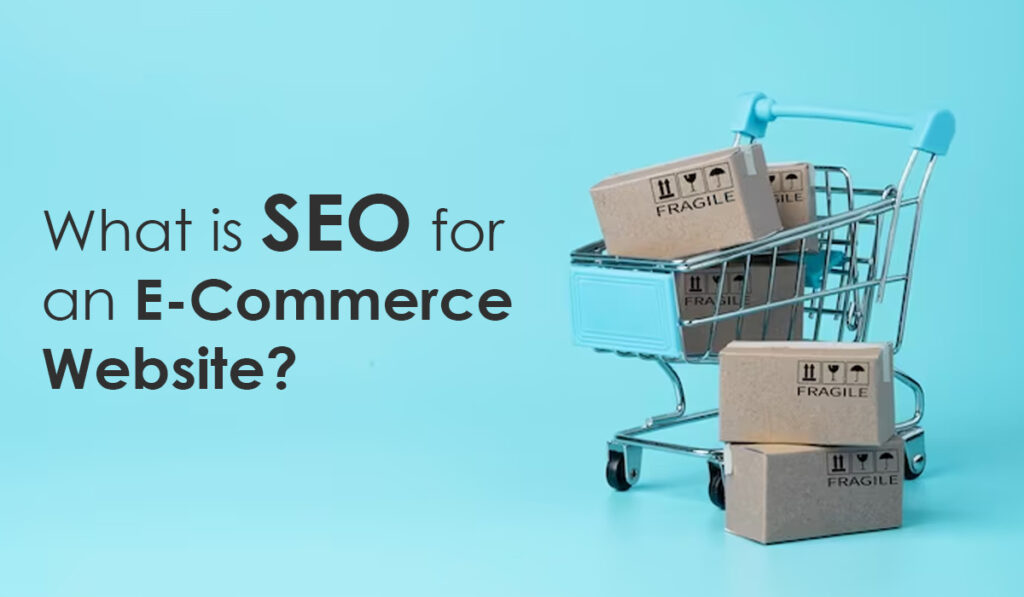A properly optimized e-commerce website is necessary if you sell things and want to reach the largest audience possible.
Why? Well, there are several advantages.
A solid SEO strategy for eCommerce website can help you learn the fundamentals about your clients, such as their locations, age ranges, and how they found you. By implementing tracking, you can afterwards use the data about your visitors for behaviour analysis to learn even more about them.
Yet, an e-commerce website accomplishes more than this. It can also assist you in identifying the problem areas. For instance, offers are unattractive; traffic sources don’t work, and problems with cart abandonment and their possible causes. Of course, the growth of e-commerce globally is the more obvious reason you want to optimize your site. E-commerce is expanding yearly, and this trend appears to be sustainable.
It’s fantastic if you’re already online. Yet, if you don’t take proactive measures to improve visibility, you risk being overlooked by new leads and prospects.
How do you go about that? It’s straightforward: use SEO for e-commerce.
What is SEO for an eCommerce Website?

Ecommerce SEO is the practice of increasing the visibility of your online store in search engine results pages (SERPs). To increase traffic, you want to appear as high in the search results as possible for the products you sell. Paid search can bring you visitors, but SEO is considerably cheaper.
It would help if you are still optimized for search because ad blockers and ad blindness might limit the effectiveness of sponsored search. Optimizing your headlines, product descriptions, metadata, internal link structure, and navigational structure for search and user experience is typically part of ecommerce SEO. You should have a page specifically created to attract visitors from search engines for each product you sell.
It would help if you didn’t overlook your SEO strategy for eCommerce website’s static, non-product-focused pages, such as the ones listed below.
- Homepage
- About page
- F.A.Q. page
- Blog articles
- Contact page
Make a list of relevant keywords and keywords for those pages. It is simple to search for one long-tail keyword and discover semantic keywords that fit well with it using tools like Ubersuggest.
Best SEO Strategy for eCommerce Website

1. Optimize keywords
Regarding eCommerce SEO, keywords are the main player; thus, you need to be very attentive and careful when searching for keywords for your e-commerce platform. Use the search terms that are most closely related to your products. Before putting it on a product or category page, you must determine the keyword’s search volume, cost per click, user intent, and other considerations. For keyword ideas, you can also examine the websites of your competitors. In the meantime, using long-tail keywords is advised because they frequently match user intent and boost conversion rates.
2. Optimize Product Pages for Better Ranking
Take a look at your on-page user optimization if you want to draw in and acquire new clients. That matters since a higher ranking for your website results in more organic traffic and conversions. While not every aspect of your Seo strategy for eCommerce website requires optimization, let’s concentrate on the three that are most important to online retailers in this section:
- Product descriptions,
- Images, and
- Feature reviews.
3. Make your website mobile-friendly for Google
SEO strategy for eCommerce website, this is crucial. In 2016, Google began using the mobile site’s analytics to rank desktop and mobile websites. Yet creating a functional website is just as important as having one that looks attractive. UX covers many factors, including website “feel,” usability, and navigation. You will lose ranking if your mobile user experience is poor.
Several aspects can affect user experience, but the following stand out as essentials:
- SEO strategy for eCommerce website needs to be clutter-free and simple to use.
- Your website should load swiftly and work well on mobile devices.
- Advertising shouldn’t obstruct a user’s ability to access the content.
Finally, make it approachable and maintain a consistent design throughout.
4. Emphasize on-page SEO
The primary factor for any SEO strategy for eCommerce website to rank on the search engine result pages has always been on-page SEO. When we discuss on-page SEO in the context of an eCommerce website, it mostly refers to optimizing the product and category pages to rank higher for the targeted keywords and attract relevant traffic and conversion rates. Although the methods for On-Page SEO of an eCommerce site are somewhat similar to those of other websites, there are certain additional strategies that you should also take into account. The following is a list of some of the most important On-page SEO types in digital marketing services for an eCommerce site:
- Use meta descriptions and titles that are optimized.
- Make your URLs brief and keyword-rich.
- Include the main and LSI keywords in the product descriptions.
5. SEO Branding
Use your brand name in your marketing materials, including emails, videos, and meta tags. Although it sounds straightforward, many businesses ignore this tactic that can support brand development. An SEO campaign for brands focuses on numerous long-tail keywords, such as “Bose over-ear wireless noise-cancelling headphones.” Wireless noise-cancelling headphones come in various designs, but only one “Bose.” By including your brand, it will logically ascend to the top of the SERP, owing to its relevance.
6. Don’t use duplicate content or pages
Have you ever visited a website and felt you had already read everything? When online shops employ duplicate product catalogs and photographs, that is a problem all too frequently with production descriptions and category descriptions. It makes sense why online retailers repeat the same information. Generally, they only lack the means to create new content independently.
Even if you don’t have time to redo everything completely, you can still cut down on duplication in product descriptions and other places on your seo strategy for eCommerce website.
7. Create Quality Backlinks
Backlinking has long been regarded as the SEO strategy for eCommerce website that is the most legitimate and deserving. And in the case of e-commerce SEO, it becomes much more important since if your platform is endorsed to the public by some reliable resources, it can significantly increase traffic on your SEO strategy for eCommerce website.
While constructing backlinks, it’s important to bear in mind that the third-party source must be reliable and the linking must be pertinent to your niche because spammy or irrelevant connections can cause your site to be punished. Your e-commerce site can begin to gain backlinks in several methods, including by using infographics on social media, submitting to directories, leveraging Q&A sites like Quora, and more. Guest blogging is the finest method for obtaining high-quality backlinks because search engines favor it the most.
8. Employ Schema Markups to Make Content Clearer to Users and Google
HTML tags, known as schema markups, offer more details about the content on web pages. Your Seo strategy for eCommerce website activities can be improved by applying these markups. Rich snippets are produced through schema markup. They give search engines a means to provide more details about particular objects in the search results. By displaying several forms of information, they also assist users in finding what they seek more quickly and easily.
There are numerous varieties of rich snippets, including:
- Review snippets,
- Audio snippets, and
- Product markup snippets
9. Insert a Sitemap
The visual depiction of your Seo strategy for eCommerce website or digital goods is called a sitemap. Visitors can explore several sites and get a bird’s-eye view of the website. Your website’s pages, from category to product pages, should be listed in your sitemap. The goods, subcategories, and other information in those sections should also be included. A sitemap can be created manually or automatically using a programme like Google’s Webmaster Tools. Both XML and HTML are used in sitemaps, albeit HTML sitemaps are more beneficial to users.
10. Make each product’s description distinct
When it comes to eCommerce SEO, it is the most ignored factor. And in some ways, it makes sense because it can be challenging to write a unique description for each product on an e-commerce platform where there may be several items in the same general category. Yet, using the same descriptions causes content duplication problems that affect your site’s rating and, consequently, lower traffic and conversion rates. Because of this, it is even more important to provide a compelling and distinctive description for each product. The following are some pointers for creating a product description:
- Write product descriptions that are nearly 1000 words or more.
- Use the primary keyword three to five times in the description.
- The LSI keywords should be evenly distributed (without stuffing irrelevantly).
- Add modifiers like “Purchase” and “Sale” as well as click-attracting keywords like “50% OFF,” “Free Shipping,” and so forth.
11. Make social sharing simple
Many would disagree with Google’s Matt Cutts’ claim that social sharing has no bearing on SEO. Social media sharing may not directly impact your SEO, but it does improve brand exposure and familiarize people with your company. Also, the more social media mentions you receive, the more of an impact this can have on your SEO:
- Driving natural traffic and raising awareness
- Optimizing local SEO,
- Extending the reach of your content, and boosting brand recognition
12. Ensure site security
Maintaining the website’s security is crucial because an e-commerce platform handles the data of millions of users and processes a significant volume of transactions every day. Also, customers are becoming more cautious and want a more secure Seo strategy for eCommerce website due to the fast-rising occurrences of cyberattacks on e-commerce platforms, such as the disclosure of banking details and account hacking. And sure, while ranking your site on SERPs, the search engine also considers its security.
To protect sensitive data or information, you must ensure that your e-commerce site has HTTPS and SSL certifications. SSL (Secure Socket Layers) adds an extra layer of security for data encryption. At the same time, HTTPS (Hypertext Transfer Protocol Secure) enables the browser to establish a secure connection to the server over a common port.
Also, you should always make a backup of the site’s data so that, if it is lost or corrupted, you can easily restore it without upsetting the site’s visitors. To further reduce the danger, you should advise users to change their account passwords and update seo strategy for eCommerce website routinely.
13. Add internal links to pertinent products, categories, and resources
Although it is commonly believed to be an out-of-date tactic, creating internal links within the on-page SEO strategy for eCommerce website is still incredibly valuable and effective. Your site will appreciate your effort in inserting pertinent internal links across on-page material and articles written for readers rather than search engines.
Internal linking is a natural technique to improve Google’s understanding of your SEO strategy for eCommerce website and content, so long as you’re not cramming your site with keywords or adding pointless connections. Anchor text for internal links should be similar to the keywords in the page’s title tag and include keyword suggestions from your keyword list.
14. Encourage customer testimonials and participation
Structured Data is wonderful for showing things like reviews in the SERPs, but if your page already has two reviews, it doesn’t seem so great. Build an application with incentives to motivate your users to post reviews. Your strategy should go beyond reviews, emphasizing interacting with your previous, present, and potential clients. Online shoppers respond to incentives and repeat consumers are extremely advantageous in the eCommerce business.
15. SEO for eCommerce Successes in the Click War
Using Google’s best practices for your page optimization makes it easier for search engines to find your pages and improves your ranking. These recommendations should be true for a while, even if Google frequently changes its algorithm.
You have a competitive advantage over SEO strategy for eCommerce website not optimized with eCommerce SEO. More significantly, your clients will easily find everything they need and check out. Good UX encourages customer loyalty. You have the opportunity to sell more frequently with effective SEO.
16. For e-commerce, content is important
There is more to e-commerce than just graphics and keywords. You should also incorporate written content into your SEO strategy for eCommerce website. Regular content posting also increases organic traffic. It can help you win over clients, improve website rankings, and establish your authority in your field.
You can concentrate on a variety of content types, including:
- sharing tutorials and responding to queries
- new product introductions and noteworthy events
- an index page
- comprised of user-generated content (UGC)
17. Use a Basic URL Structure
In addition to improving the user experience, a straightforward URL structure can help your e-commerce SEO efforts. It’s also simpler to share products on social media and other websites when your e-commerce site has a straightforward URL structure, which helps boost SEO for e-commerce by giving search engines more relevant information. URLs should be as legible and understandable as possible for the greatest outcomes.
18. SEO Outsourcing
It can be challenging to complete all of the tasks above on your own if you’re busy; therefore, it would be best to outsource the SEO procedure. But you shouldn’t just pick any consultant or firm and hope for the best. You must strategically select the best candidates to implement a comprehensive SEO plan. Start by evaluating SEO firms and independent contractors in your city. You should be able to find their client ratings and reviews by SEO strategy for eCommerce website and unbiased review sites like Google Business.
19. Examine the first page of Google
Well, so you discovered a few keywords. See who currently ranks for those keywords right now. To do it, enter one of the terms you discovered into Google. Examine the first ten results. Hence, if you wish to write about that subject on your Seo strategy for eCommerce website, you should know that list posts make up most of the first page results. Moreover, you should probably write a list post for your website.
20. Redirects
Users and search engines can be sent to a different URL from the one they initially requested by using redirects. Redirects will impact your SEO, but whether this is for the better or worse depends on various circumstances. Search engines frequently use unique URLs to identify them.
After Google evaluates the page and the redirect, it will make an effort to determine how relevant the new page is to the keyword on the original page. Be sure the old URL and the one being redirected are related, or you risk losing SEO rankings.
21. Guest posting
Link building is made easier by utilizing guest posting on sites and in articles. It can assist Seo strategy for eCommerce website in developing connections with industry leaders and websites, leveraging their knowledge and audience to broaden the exposure of your website. You can improve your SEO keyword rankings by gaining high-quality links to and from your site through guest posting.
22. Decrease page load time
Moreover, page load time affects rankings on both desktop and mobile devices. Google will give you a higher ranking the quicker your pages load. How can page load time be slowed down? Concentrate on removing as many extraneous elements from your page as you can. For instance, it might not be essential to use a large background image largely hidden by a white body column. Remove any plugins or add-ons that don’t improve the bottom line of your e-commerce business.
Final Words
These are some most important Seo strategy for eCommerce website that can help you rank higher in search engine results pages, bringing you more visitors and improving your conversion rates. Hence, maximize your online platform to rule the eCommerce business and don’t let any opportunities pass you. Your ecommerce site will rank higher in the search engines and provide more leads for your C.R.O. efforts if you follow those recommendations.

